Historical Rock Climbing
Images
|
Page
3
Elbsandsteingebirge Kletterschule, Gymnastics Perry-Smith |
| Difficulty
and
Risk - two sides of the same coin . . . Perry-Smith accompanied A. Kunze and H. Simon on an ascent of an Elbsandstein wall - the Lokomotive-Esse - in 1903, a climb that demonstrated the possibility of engaging an open face of rock rather than a chimney or crack. Thereafter, difficult wall climbs became an accepted part of the game. Oliver's initial lead of a first-ascent was a climb of Schrammtorwächter (VI = 5.6/5.7) in September of 1905. In the first official evaluation of Saxon rock climbing, in 1908, he is described as having done more than 90 ascents, 33 which were rated as VI or above; 32 first ascents, 13 solo climbs, and 36 additional climbs he led. The young man from America was phenomenally talented. There is little question that he exhibited enormous courage and determination, coupled with a powerful climbing style that left some of his admirers (and detractors) confounded. Fehrmann refers to "His bear-like strength". Of Perry-Smith's 1906 ascent of the Teufelsturm , Original Route (Saxony grade: VIIb = 5.8+ - with shoulder stand), Fritz Wiessner believed that the young Philadelphian turned Dresden resident achieved a point in free climbing technique "close to the limit of the possible". (Note: Wiessner and Perry-Smith were not contemporaries - Wiessner was born in 1900, and was only 13 when Perry-Smith did his final climbs in Elbsandsteingebirge.) |
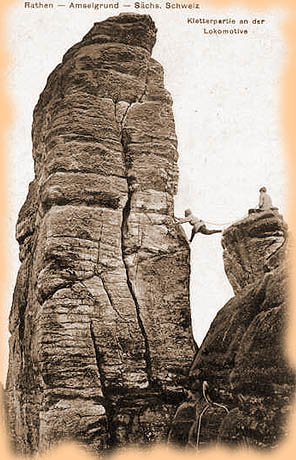 An Early Postcard of Climbers on the Lokomotive |
| Before
World War I, rock climbs in the Alps by such luminaries as Preuss,
Herzog, and Dülfer probably didn't exceed Grade V. It took the
spectacular efforts of the specialists from Dresden to raise the bar. Thorington states unequivocally: "Before the first World War 6th degree free climbs (present alpine rating - 5.9), with little protection, existed only in Saxon, Switzerland. Perry-Smith was the first to master this degree." Looking at the records, however, it would appear that Rudolf Fehrmann held equal status in this regard. The question of whether or not Perry-Smith and his companions reached the very highest levels of pure technical or gymnastic skill existing anywhere during the period 1902 to 1913 - without regard to the risk of a fall - is an open one. One reputable internet source describes progress at Elbsandsteingebirge as: 5.9 by 1906 and 5.10a by 1910. Other sources show ratings of 5.8 by 1906 and 5.9 by 1910. With over a hundred years of climbing, routes on rock considerably softer than granite are bound to change, so one can only speculate how it was for the pioneers. Also, until the 1940s it was common practice to employ shoulder stands and other similar forms of assistance - and still regard the climb as "unaided". This was a natural consequence of viewing a climbing team as "two climbers - one climbing unit". What seems clear, however, is that levels of danger and degrees of commitment were nowhere higher than in Saxony. Whereas a short pitch of high difficulty on British rock may have required courage and great technical skill, the runout on a climb like the south crack of Falkenstein - nearly dead vertical for 450 feet of fist jamming, off-width and squeeze chimneys, with no real ledge systems - trailing an 80 foot hemp rope on a highly speculative ascent with no clear way to retreat, must be seen as a truly astounding, though some would say misguided, feat of athletic daring. Kudos to those great adventurers. |
Kletterschule
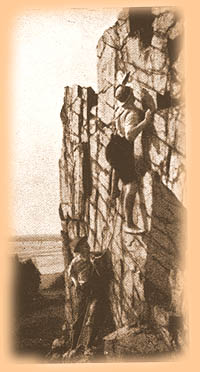 Leipziger Kletterschule (1930s) |
Certainly, British climbers - Oscar Eckenstein in particular - had done very hard boulder problems by the turn of the century, whereas Perry-Smith's group must have felt that such activities were unimportant, and that real climbing was as much risk as difficulty. Photos from those times show that "practice climbing" (Kletterschule) was frequently practice in leading, sometimes with little protection. However, for the British, whose sense of playful eccentricity was well honed, bouldering was not seen as inconsequential, at least by a core group of enthusiasts - including strong advocates Oscar Eckenstein and Claude E. Benson. | 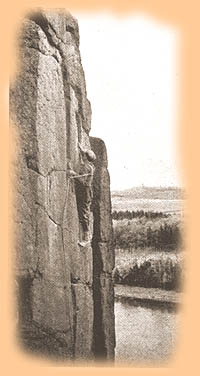 Rampenwand |
| Geography, of course, plays a significant role in these matters. Where long climbs are easily accessible and waiting to be done, the character of the rock demanding enormous risk and the spirit of competition high, playing on boulders - for these early climbers - held little attraction. For the British, however, living in large cities distant from the larger cliffs, testing the limits of their gymnastic skills on small boulders and outcrops was a much more reasonable practice. The same could be said of the French 'Bleausards twenty years later, living in Paris and practicing at Fontainebleau. |
Risk . . . Gymnastic Preludes
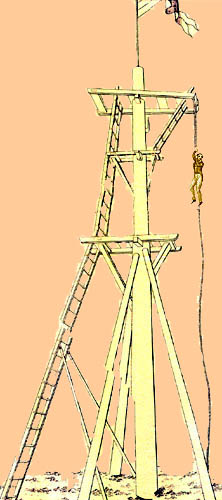 Jahn's Der Einbaum From Die Deutsche Turnkunst, Berlin, 1816 |
Risk
. . . Early Gymnastics . . . The criticality of danger - in this case risk arising from exposure - has a lineage in German culture that is seen in some of the apparatus the Father of Gymnastics, Friedrich Jahn, designed for his Turnplatz at Hasenheide, almost a century prior to Perry-Smith's adventures. Indeed, Jahn's program for young men was laced with irredentism and ultranationalism and was martial in tone, promoting courage as well as strength and agility. Early gymnastics was quite different from the sport of today, and Jahn built giant scaffolds supporting long ropes and poles, encouraging his pupils to practice their climbing skills with no protection high above the ground - an historical precedent for future climbing in Saxony. For more about early gymnastics & climbing, go to Climbing & Gymnastics |
| Protection
. . .
Although, in Saxony, permanent rings were inserted by the leader at a few critical spots on a first ascent, photographs demonstrate that a premium was placed on courage. At a price. Thorington (1964) comments: "The death rate has always been high, mainly due to rope breakage and because the climber was not equal to the task". Soloing . . . And in the alpine world the cult of solo climbing resulted in a number of early fatalities, including the promising, and very young, Georg Winkler (18) in 1888 as he attempted a solo ascent of the Weisshorn. Some years later, prior to the beginning of the Great War, Dr. Paul Preuss, at the age of 27 and one of Germany's brightest climbing stars, fell to his death in the Alps on a solo attempt of a new route. Like Fehrmann on his sandstone towers, Preuss shunned what he labeled - and subsequent generations called - "artificial aid". Perry-Smith and his companions soloed numerous climbs on the sandstone of Saxony. |
More
on Perry-Smith . . .
| Perry-Smith,
the man . . . Two incidents demonstrate the elasticity of young Perry-Smith's personality. In the first, we see evidence of a streak of cruelty - although perhaps merely a facet of youthful hubris - that is nudged to the surface by a rather benign provocation: a beginner on Oliver's rope was a bit boastful. Rudolf "Petrus" Fehrmann reports: " . . .Oliver gave him the malicious advice to go down the south wall instead of the usual ridge. All went well in the beginning, but then hand and footholds gave out. 'Hold, hold, I'm falling!' cried the unlucky fellow. Oliver replied with pretended anger: 'That's no loss; fall into hell where you belong'. 'Hold tight, hold the rope tight!' 'Goddam, I can't hold you', sounded from above. 'I must cut the rope, I have no desire to fall on your account.' A cry of anguish from the depths at last brought Oliver to call to me: 'You, Petrus, have him on the rope. You must pull him over to you.'. And so it worked; the poor fellow swung through the air, while Oliver stood upright on the narrow ledge and paid out the rope. As the victim hung free in the air and flailed with arms and legs, Oliver slowly spoke memorable words to me, which I can never forget: 'See, Petrus, the lovely picture, how he hovers, like an Eagle!' " [Aleister Crowley, a few years prior, had dangled a poor preacher off a large overhanging boulder in the Arolla Valley in Switzerland, after sandbagging the innocent man into attempting a climb beyond his capabilities. But even Crowley had refrained from cursing the pathetic parson!] |
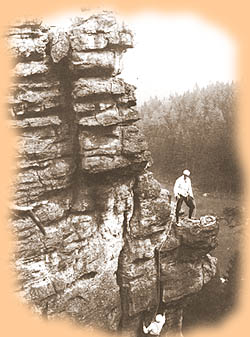 Perry-Smith leading Hauptwiesenstein, Alter Weg (VIIa = 5.7/5.8), 1913 Photo
Walter Hahn
|
| Several
years later, however, on the Guglia
di Brenta, Fehrmann - leading - found himself in
a bad position, with Perry-Smith also in a risky spot. Fehrmann called
to Oliver to unrope, since he couldn't hold the two of them and there
was no reason for two climbers going down instead of one. Oliver
replied, indignantly, "What
do you think I am, man or beast?
Either I hold you or I drop with you."
Fehrmann continues: "Is it any
wonder that, despite his mistakes and weaknesses, I loved this man like
a brother?" Perry-Smith clearly had a more benign sense of humor than is inferred by the incident with the boastful novice. As an example, he did a nocturnal climb of one of the most difficult towers in the Elbsandsteingebirge, carrying up a bicycle that he left as a surprise for the next party. One of Perry-Smith's old companions speaks of his character: "Perry-Smith was a man full of extremes and surprises, true to his friends, retiring with strangers, sometimes tender and lovable as a child, sometimes raging in anger. He was frivolous and untroubled, foolhardy and audacious, and did things on a grand scale as long as his means lasted. His only fear was of the German police. His picture rounds out with mention of the unique fractures of his German speach. And so it is understandable that he is not forgotten by us in Saxony, in Austria, in Switzerland and Norway." - Hans Pohle in Jahrbuch für Touristik, 1954. And his close comrade Rudolf Fehrmann had this to say: "Perry-Smith was the strongest individual personality I have ever known. He had a flair for the super monumental, whether it was to find new routes on rock or ice, to drive his Bugatti racing car along the highways by night, or in friendly carousal to lift many a glass. He was no saint and did not care to be one. Only a few really knew that in this sometimes rough, sometimes tender youth there beat a chivalrous heart." (Bergsteigen in Sachsen, 1936) |